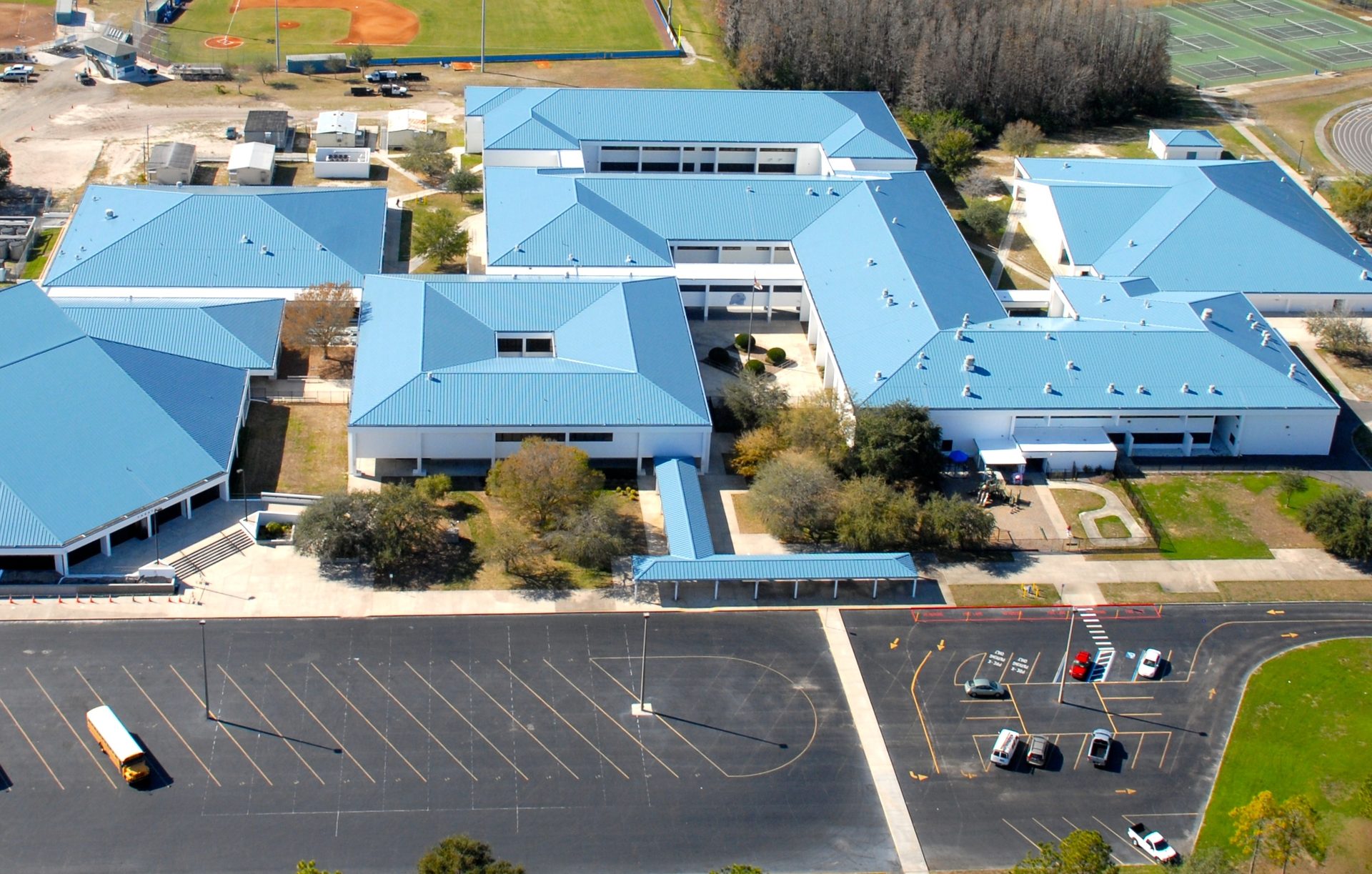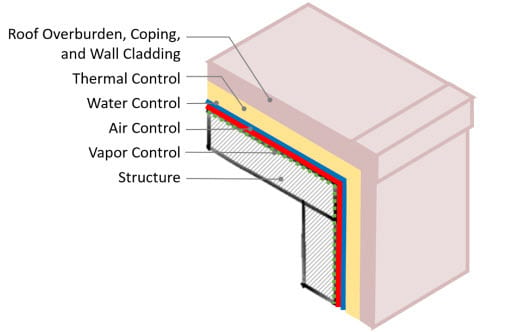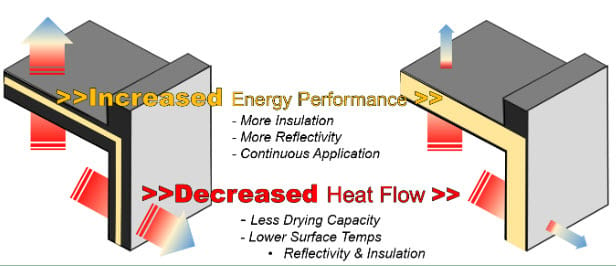
AIA Course: #BE2023GAF2
Earn: 1 AIA LU/HSW; 1 IIBEC CEH; 0.1 IACET CEU
To complete the quiz and receive a certificate of completion, follow this link: ce.buildingenclosureonline.com/BE2023GAF2
Sponsored by:
Learning Objectives:
After reading this article, you should be able to:
- Analyze design strategies to prevent moisture and air intrusion in schools and hospitals to protect occupant health, building integrity, and efficiency.
- Assess the importance of air, vapor, and thermal control design and layer continuity.
- Explain the interplay between air control, air barriers, and energy efficiency.
- Examine high-performance roof options for schools and hospitals, including membrane types and attachment methods that enhance energy efficiency.

An elementary school in New Mexico faced a series of complex challenges with the roof: these included tight budgets, a short installation window, and an existing single-ply roof coming apart at the seams. To further complicate matters, the timeframe placed half of this project during New Mexico’s Monsoon Season. This required diligent planning, coordination, and scheduling to make sure everything on the site was covered and protected before the storms hit. Completing the project by the December goal also presented a challenge, as the selected fluid-applied system had to be installed and cured in temperatures of 50 degrees and rising. After thorough inspection and diagnostics, including an infrared thermography scan and moisture scans, the installer determined that several of the existing 11 roof sections had moisture trapped within the system and needed to be removed and replaced. The school’s new roof had to perform, be efficient, and to better the indoor air quality for its vulnerable occupants—the students. To meet these goals, new tapered ISO insulation and a peel-and-stick base sheet were selected, as well as a fully reinforced, fully adhered acrylic elastomeric system. The elastomeric system quickly rose to the top choice, based on its sustainable and highly rated nature. The new roof is energy-efficient, durable, was simple to install, did not require heavy equipment on the roof, is certified as low VOC, is easy to maintain, and comes with an excellent warranty. The selected system is also FM-4470 rated as a complete roofing system. These features and benefits were very attractive to Las Cruces Public Schools.
“Our roof project at Doña Ana Elementary School went exceptionally well. For such a major project, there was minimal impact on our learning environment. We were impressed that the noise level was minimal, and the smell of the product was hardly detectable. Student safety and learning was at the forefront of all decisions,” said Cherie Love, Principal, Las Cruces Public Schools.
Selecting the best roofing assembly for schools and healthcare facilities means focusing on project constraints including timeline, weather, facility operations, and occupants. Roof integrity and performance cannot be compromised as functionality, durability, and energy efficiency must come together to create the roof assembly that is best for each individual facility.
The final complete roof system selected forDoña Ana Elementary School and installed by RoofCARE is energy-efficient, durable, and was simple to install. Photo courtesy of GAF.

Scientific Principles in Efficient Roof Design
The built environment impacts the surrounding natural ecosystem, economy, occupant health, and productivity. Practices targeting energy efficiency and resilience can substantially reduce or eliminate negative environmental impacts and improve existing unsustainable design, construction, and operational practices. For healthcare and educational facilities, one can argue that practices that impact occupant health are paramount.
When designing an assembly for educational and healthcare facilities, it is critical to consider all elements of high-performance roof design. Efficient design can lower a building’s operational costs, increase building values, protect assets, and increase profits. It also can improve employee productivity and satisfaction, reduce sick days, and contribute to the building’s sustainability goals. Efficient buildings may enhance air, thermal, and acoustical quality, improve occupant comfort and health, and advance overall quality of life.
The roles of efficiency are met by different layers in the envelope assemblies, whether they are roof, wall, or foundation. No longer “just” a roof to keep precipitation out, today’s roof has many roles. For the high performance roof, these include effectively handling temperature and thermodynamics, relative moisture risk, and uncontrolled air. Failure to plan for even one of these elements, or planning incorrectly, frequently results in energy loss and inefficient operations. Efficiency, from a practical sense, can be related to HVAC demands, which ultimately impacts monthly heating and cooling bills. For hospitals and schools that typically have large building footprints, controlling energy efficiency can have a substantial impact on the bottom line. Incorporating high-performance systems, including the roofing assembly, can contribute to the overall energy efficiency of the building.
One of the primary purposes of a building enclosure, which is inclusive of all six sides of the building, including the roof, is to keep moisture out of a building. What makes this difficult is that moisture comes in many forms and can take many paths into a building. Building designers need to account for bulk water, capillary water, air-transported moisture, and water vapor, and must defend against each of these in different ways. For the wall of an enclosure, achieving a 100 percent successful water barrier is unlikely. Walls, with their many penetrations, including doors and windows, are difficult to make entirely “waterproof.” Good wall designs accept the fact that some water ingress might occur and include a drainage path down and then out of the structure without damaging it. This, however, is untrue for the roof assembly. Roof assemblies must be watertight and designed so that water is not able to enter into it. The water control layer in roofing assemblies is the membrane. For hospitals and educational facilities, the tolerance for leaks is low, which amplifies the need for a high-performing building enclosure.
There is one rule that defines how heat, air, and moisture move—the second law of thermodynamics. In terms of building and roofing science, this simply means that: hot moves to cold, moist moves to dry, and high-pressure moves to low-pressure. Heat, moisture, and pressure always equalize whenever possible. While preventing water ingress was a primary function of the first building enclosures, keeping occupants secure from rain and snow—thermal control—keeping inhabitants from freezing in winter and roasting in summer became an auxiliary function. Today’s low-slope roof assemblies typically use an insulating foam such as polyiso to aid in temperature control. Good design is important so that the effects of thermal bridging and penetrations are accurately considered. There is not only a code requirement for continuous insulation, but it is a good practice to eliminate thermal bridges where interior conditioned air loss may occur. Student and patient comfort is critical in learning and recovery environments, and mitigating loss of conditioned air to maintain set temperatures is an important component.
Building science experts identify air leakage as a major impediment to achieving better energy efficiency for the building enclosure. Essentially, the goal of an air barrier (in warm environments) is to prevent the loss of conditioned air from the interior to the exterior and the introduction of warm, humid air from the exterior to the interior. Just as thermal control needs to take into account thermal bridging, a material that only blocks air is insufficient in and of itself. Instead, an effective air barrier acts as an interconnected series of materials spanning the entire enclosure. The requirement for a continuous air barrier is a code requirement, but it also assists in ensuring that the pressurized spaces stay pressurized appropriately. For hospital settings where negative pressure rooms are required, it is important that the room is sealed appropriately to prevent contaminants from exiting the room. The requirement for an effective air seal must be considered at the roof level, to ensure that there is no loss of pressure through the roof assembly.
In simplicity, the main control layers for a roof assembly consist of water, thermal, vapor, and air control. The roof membrane and thermal insulation play a pivotal role in water and thermal control. However, the use of air barriers and vapor retarders also has import for the roof and can be a source of confusion, particularly for high performance and energy efficient roofs. The order and sequencing of these layers is strongly influenced by roof edges, or terminations of the roof assembly. This means that how the roof is tied into, or connected with, the wall and its various control layers has a large influence on the order of the layers and which controls might be carried out by each layer. This is particularly the case when discussing air barriers and vapor retarders.
Simplified version of continuity of control layers from a roof to wall. Image courtesy of GAF.

As more materials and additional requirements are added to enclosures, including air tightness, it is important to recognize when materials and assemblies need to adapt in order to achieve higher energy performance. As energy efficiency is improved in building enclosures, moisture risks can increase from decreased heat flow and air movement across the assemblies. Unintended and uncontrolled air movement, vapor movement, and control layers that are not continuous across building enclosures can trap moisture within roofing assemblies. Proper design and installation is important to meet both performance and building code requirements. This is true for any facility, not just hospitals and educational buildings, although the risk associated with moisture in these structures could arguably be higher. Mold growth, which is a possible consequence of moisture, deteriorates indoor air quality (IAQ) and can be deadly for those with weakened immune systems.
Energy efficiency improvements can lead to increased moisture risks in a building enclosure. Image courtesy of GAF.

Operation Moisture Risk Elimination
In present day building codes, with their heightened emphasis on efficiency, it is ever more crucial to control moisture ingress into wall and roof assemblies. Importantly, control of moisture ingress from air leakage at assembly joints and vapor diffusion through materials can be achieved either using layer material specifically designed for the purpose, or through careful installation of, for example, the vapor thermal or air barrier control layer. All materials in a roof or wall assembly have some vapor retarding properties and the choice to include a specific vapor control layer should be made in consideration of the local climate, the building use, and the degree of assurance that vapor movement is retarded sufficiently.
The impacts from moisture intrusion are many. Certainly, leaks from the roof cause costly repairs, but they also can deteriorate the roof assembly and lessen its performance, including reducing R-values in the insulation, damaging interior finishes, and facilitating mold growth. Additionally, poorly controlled water ingress affects indoor air quality as mold growth in the roof assembly will find its way into the interior airspace of the building. In school and healthcare facilities, preserving IAQ and occupant health is paramount.
Bulk water
Bulk water, such as rain and snow, is kept out of buildings with roof membranes and wall cladding systems. Initially, roofs were created for this purpose. Keeping out bulk water consists of watertight detailing that is typical for any roof assembly. For facilities aiming at high levels of efficiency, including air tightness in conjunction with water tightness is a vital detail. Often, the roof membranes will serve as the air barrier, so proper detailing at penetrations and perimeters is vital. This includes tie-in with exterior wall assemblies to ensure a continuous air and water barrier.
Air-transported moisture
Air-transported moisture, as the name implies, is carried into or out of a building by air that infiltrates or passes through the building envelope. There are several types of air conveyance that can occur through the building envelope. Air infiltration is where exterior air enters the building through gaps in the exterior enclosure. Intrusion refers to the interior air that enters a roof or wall system but does not exit to the exterior. Interior air can be problematic where interior activities cause raised humidity levels in the air, one such example is in a gym, which are often located in both schools and hospitals. Large congregations of people exercising and exhaling increase moisture levels in the air; not to mention that shower facilities are usually adjacent to gyms, which also increases air moisture levels. Where uncontrolled moist air from gyms or showers enters into the roof assembly, condensation can form, often developing within the roof assembly. Condensation within the roofing assembly is not likely to evaporate, and this can lead to wet insulation, roofing components with lowered R-values, water accumulation in the roof deck, and the possibility of fostering mold.
Air exfiltration occurs where interior air exits from the building, also through gaps and inconsistencies in the building exterior. Exfiltration can lead to inefficient HVAC systems, where the building heating and cooling systems have to work harder to maintain interior temperatures, which ultimately leads to higher energy bills.
Air transported moisture. Image courtesy of GAF.


